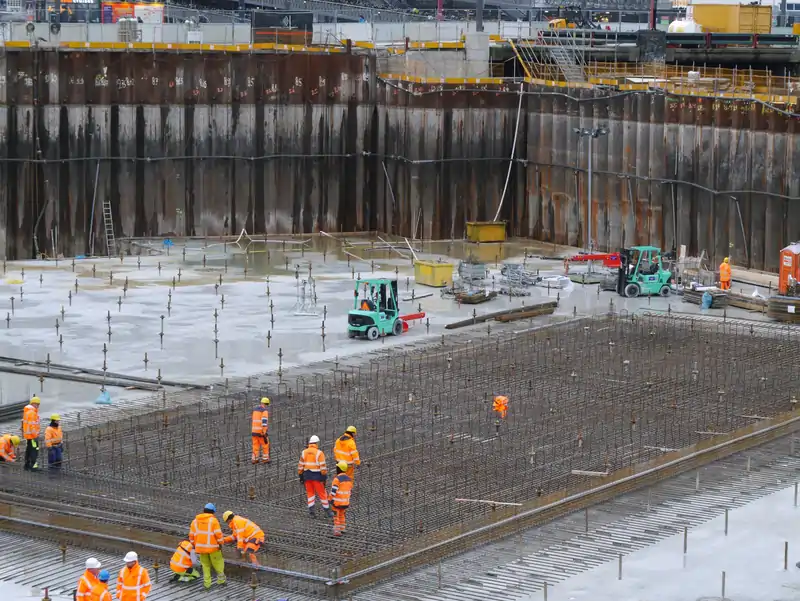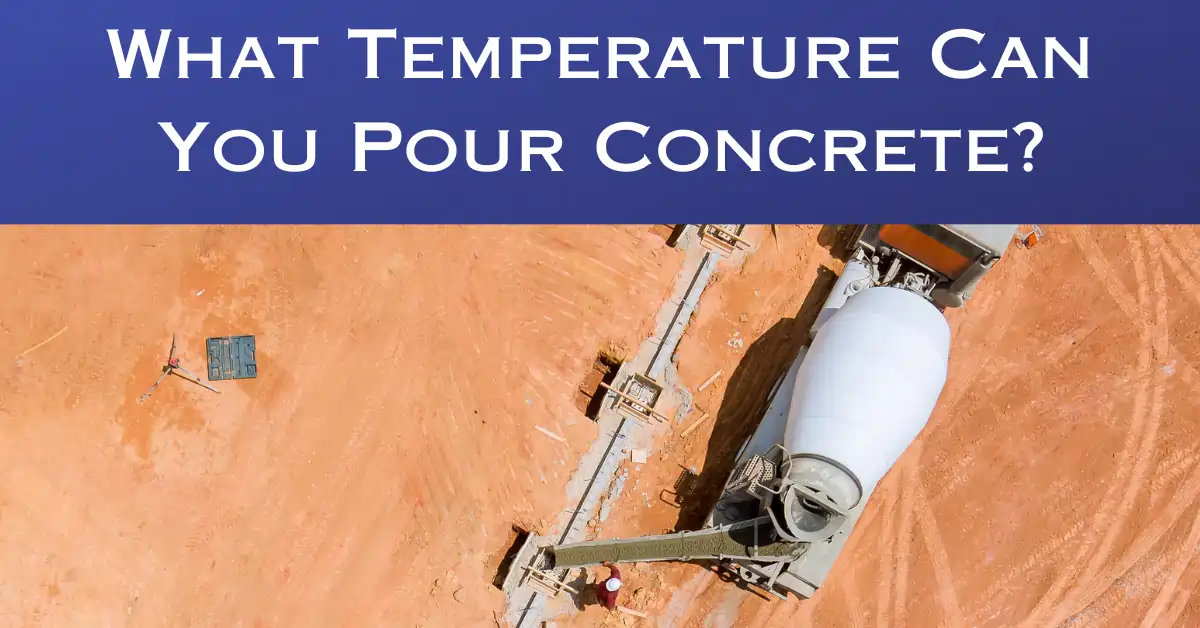Concrete is one of the most versatile and durable materials for construction, but it also requires careful attention to the environmental conditions during its placement and curing. One of the most important factors that affect the quality and performance of concrete is temperature. Temperature can influence the rate of hydration, the setting time, the strength development, and the durability of concrete. Therefore, it is essential to know what temperature can you pour concrete and how to control it.
The Ideal Temperature for Pouring Concrete
The ideal temperature for pouring concrete(concrete at discharge) is between 50°F to 95°F (10°C to 32°C). This is specified in ACI 207 and ACI 305. These ranges correspond to the minimum temperature for cold weather concreting and the maximum temperature for hot weather concreting. Our temperature calculator can help us understand the influence of temperature on concreting graphically.
The temperature at the placement of concrete affects the quality of concrete because concrete gains its strength and durability through a process known as hydration, which is the chemical reaction between water and cement. Hydration can be affected by conditions of extreme heat or cold, which can either accelerate or slow down the reaction.
If the temperature is too high (above 90 degrees Fahrenheit), hydration can occur too fast, resulting in rapid setting, reduced workability, increased shrinkage, cracking, and lower ultimate strength. If the temperature is too low (below 40 degrees Fahrenheit), hydration can occur too slowly, resulting in delayed setting, increased bleeding, reduced strength gain, and risk of freezing.
Therefore, it is advised to pour concrete at a temperature between 50 and 95 degrees Fahrenheit, which allows for optimal hydration and strength development. However, this may not always be possible due to seasonal variations or geographic locations. In such cases, some measures can be taken to adjust the temperature of concrete or protect it from extreme temperatures.
ACI 301 restricts the temperature difference between the near-surface((average daily ambient temp) and the core to a maximum of 35°F. It also specifies a maximum core temperature of 160°F. That is because temperature differences can cause thermal stresses that cause cracking.
The effect of temperature is much greater in large concrete sizes because of the high core temperature due to the mass effect. For this reason, the definition of mass concrete is introduced to efficiently control the concrete placement of large-sized concrete.
For a concrete placement of mass concrete, the regulations and specifications require that a thermal control plan is prepared and the concrete temperature is monitored during and after placement.

How to Control the Temperature of Concrete
The placement of mass concrete shall be performed with well-organized and planned temperature control measures. In mass concrete control the two temperature limits that need to be considered are the ACI 301 limits mentioned above.
The difference between the surface and core temperatures can be controlled passively by choosing the right materials, timing the removal of the formwork, and preparing the placement of the concrete to coincide with cooler ambient temperatures. The other techniques, which are active ones, include cooling concrete, precooling coarse aggregate, pumping cold water through pipes that are embedded, and wrapping newly laid concrete in insulating blankets.
What is considered mass concrete is loosely defined. “Any volume of concrete with dimensions large enough to require that measures be taken to cope with generation of heat from the hydration of the cement and attendant volume change, to minimize cracking,” according to ACI 116R,1 is considered mass concrete.
However, this definition that relates only to size is incomplete. The mass concrete effect also depends on the material and construction type.
As we have discussed mass concreting needs control measures. There are 4 main categories of temperature control methods before, during, and after pouring. Temperature control is required for mass concrete in order to control the strength attained and the durability of the concrete.
1.Cementitious material content control: Choose the appropriate type and amount of cementitious materials to reduce heat generation potential.
2.Precooling: Lower concrete temperature by cooling ingredients before placement.
3.Postcooling: Extract heat using embedded cooling coils to limit temperature rise.
4.Construction management: Implement strategies to prevent excessive temperature differentials, involving concrete handling, scheduling, and procedures.
Further Temperature control approaches vary based on project size. Small structures may require simple measures like placing during cooler periods. Larger projects can demand a combination of control measures for optimal results. Thinner sections have higher temperature limits as less heat can be retained.
Some of these methods utilized in temperature control are:
- Use hot or cold water to mix the concrete, depending on whether you want to increase or decrease the temperature of the concrete.
- Use ice or liquid nitrogen to cool down the concrete, especially if you are using warm aggregates or cement.
- Use heated enclosures or blankets to warm up the concrete, especially if you are pouring in cold weather or at night.
- Use additives or admixtures that can modify the setting time and hydration rate of concrete, such as accelerators or retarders.
- Use sunshades or windbreaks to protect the concrete from direct sunlight or wind exposure, which can affect the evaporation rate and temperature of the concrete.
- Use curing compounds or membranes that can seal the moisture and heat in the concrete, preventing loss of water and temperature.
- Monitor the temperature of the concrete using thermometers or sensors, and adjust accordingly.
- Managing aggregate gradings and using large-size aggregates inefficient mixtures with low cement content.
- Precisely cooling aggregates and mixing water or using ice during batching.
- Adding air-entraining and chemical admixtures for improved concrete properties.
- Using appropriate block dimensions for placement.
- Aligning construction schedules with seasons for lift heights and placing frequencies.
- Utilizing specialized equipment for swift placement of cooled concrete.
- Employing water curing for evaporative cooling of surfaces.
- Dissipating heat through embedded piping carrying cold water.
- Insulating surfaces to minimize thermal differences between the interior and exterior of the concrete.
Cold weather concreting
What is cold weather concreting? According to ACI 306, cold weather concreting is in effect when for three consecutive days, the average daily temperature drops below 40°F.
In cold weather concreting, The general recommendations state that concrete temperature must be maintained higher than a specified temperature for a specific period of time (40°F) >5°C) for 48 hours) (ACI 306) in order to ensure adequate strength development and prevent cracking of the concrete.
Concrete setting time increases with a decrease in temperature. The quality of concrete can be adversely affected by elongated setting time, low strength development, and the risk of thermal cracking. ACI 306 recommends a minimum temperature that should be maintained during placement in cold weather conditions for different member sizes.
Hot weather concreting
What is hot weather in concreting? According to ACI 305R, hot weather is any combination of the following variables that tends to reduce the quality of freshly mixed or cured concrete by speeding up moisture loss and cement hydration or by producing other negative effects.
• Extreme temperatures outside
• High temperatures for concrete
•High wind speed, low relative humidity, and solar radiation
ACI 301-16 “Specifications for Structural Concrete” and ACI 305.1-14 “Specification for Hot Weather Concreting” limit the maximum concrete temperature to 95 °F (35 ºC).
Hot weather conditions can shorten setting time and this results in decreased placing and finishing time. Additionally, it results in an increase in water demand which results in an increase water cement ratio and a decrease in the strength and durability of the concrete. The hot weather condition causes a rapid rate of evaporation although that can be set back by high humidity.
The rate of evaporation needs to be limited for the optimal hydration and curing of the concrete. ACI provides a nomograph to assist in controlling the rate of evaporation by considering the ambient concreting temperature. Higher temperature also is not desirable since it causes loss of slump and entertained air.
In hot weather concreting, the core temperature of concrete particularly for mass concrete, during hydration is typically restricted to 160°F (70°C). The overall durability of the structure will be reduced if the temperature of the concrete during hydration is too high, which will result in the concrete developing strength more slowly over time.
Conclusion
Temperature is a critical factor that affects the quality and performance of concrete. The ideal temperature for pouring concrete is between 50 and 90 degrees Fahrenheit, which allows for optimal hydration and strength development. However, if this is not feasible due to environmental conditions, some methods can be used to control the temperature of concrete before, during, and after pouring. By knowing what temp can you pour concrete and how to control it, you can ensure that your concrete project will be successful and long-lasting.

